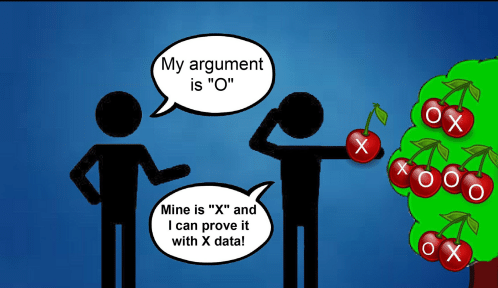
UX design is more of a scientific process than art and craft. UX and product design have to be evidence and data-driven. In this process, many mistakes can occur during decision-making that is from human bias. After all, designers are humans, and quite natural to have biases. The human brain takes a lot of shortcuts to avoid the usage of energy. These shortcuts are based on prior knowledge and experience. So according to a person’s knowledge and experience biases will be formed.
To avoid biases, we need to learn biases and fallacies first. It's not possible to be 100% unbiased, but knowledge will improve our unbiased decision-making power.
What is a logical fallacy?
Fallacies are defects that weaken arguments. A fallacy is the use of invalid reasoning. This can come many times in your UX and product design process. You may be finding a lot of information that can be biased and wrongly framed.

The logical fallacies have a long history starting from the era of Aristotle (384–322 B.C.). His book “Sophistical refutations” has mentioned 12 fallacies.
There are hundreds of logical fallacies being studied today and you can find many fallacies are overlapping with others.
There are basically two types of fallacies.
- Formal fallacies (Argument/logic)
- Informal fallacies (Content/Grammatical).
In this story, I will only be talking about formal fallacies. I have shortlisted 10 fallacies that are common in the UX design process and stakeholder collaboration.
1. Anecdotal fallacy

Anecdotal fallacy is where you consider your personal experience as evidence. Scientifically a personal experience or testimony is not valid evidence. Human memory has many limitations and it won’t be 100% accurate. There are also possibilities of the placebo effect & nocebo effect which are impacts of a person’s belief.
As designers we should not consider our experience as strong evidence, this could limit our ability to empathize with the users.
Eg. The designer may be from a Tier 1 city, who has been grown up with good resources. He/she can be biased on the thought that the users are tech-savvy, fluent with tech jargon, also with good internet facilities.
Designers should always try to look for evidence, data, and user research than relying on personal preferences.
2. Sunk cost fallacy
Sunk cost fallacy is your argument saying that just because you have put in a lot of effort into something you have to retain it. It's like trying to keep an idea or product that you have put so much effort and money into, which is useless for users.
The UX design process is a very iterative process. You may be experimenting with a lot of options. You should not be biased on an option where you have put more effort. You should always give importance to the option which is worked better.
3. Bandwagon fallacy

Bandwagon fallacy refers to the tendency of thinking that one idea or trend is good just because more people are using it.
I have my own personal experience with following a bandwagon. In 2014 Microsoft's flat design system and minimalism were trends and it was adapted by many products. Our design team embraced it in our company without examining it. After a huge project launch, we found many UX issues, especially with affordance. Later we changed our design system.
Just because something is used in many places or used by many people it does not mean that it will fit your product. You need to test it with your product. You may be a fan of minimalism but that may not be a good choice for your target audience or users.
4. Appeal to time
Appeal to time is an argument saying that something is right and should be kept because it existed for a long time. This is mostly seen in religion.
Eg: The floppy icon was used for a decade as the icon for “save”. But it is not useful in this decade as the new generation cannot relate it to the “save” action. The product you may be working on may have many features that are old for decades, but as a UX designer, you should be ready to change it if that is not useful for your users.
5. Loaded question

A loaded question is a question into which you have injected an answer which makes confusion. This is widely used in political debates and court trials.
As a UX designer or researcher, you may be taking a lot of user interviews. You need to ask questions which are easy to answer. The questions should not be loaded questions or leading questions that can influence the reply of users. Leading and loaded questions will give you wrong answers which will end up in wrong data collection. You need to record and observe your Q&A in your user testing sessions to confirm these mistakes.
6. Cherry Picking

Cherry-picking is a data collection process in research where you pick data that are affirmative to your hypothesis. Usually, political parties or organizations with some propaganda do such activities.
Research and data collection should be unbiased. If you have already made a decision and are looking for data to support it, then you will be biased. The data collection and research should be open to any info. Info can be negative about your hypothesis.
7. Co-relation causation fallacy
The above image shows data with two trend lines saying Nicholas Cage films being the reason for pool drowning deaths in the US. This is the co-relation causation fallacy.
This fallacy is also known by the Latin phrase cum hoc ergo propter hoc (with this, therefore because of this). While you collect data you may get similar trends in two data points. Just because they are having a similar trend line you can not conclude that one is the cause of another. Its co-relation, not causation.
Another version of a similar kind of fallacy is known by the Latin phrase post hoc ergo propter hoc (“after this, therefore because of this”). This can happen in AB tests. You may find some data differences in AB tests, but you need to confirm that it's because of the design change you made in the product. You need to make sure that the other possible causes like marketing campaigns or seasonality are not present in the scenario.
8. Halo effect
Halo effect is a tendency for positive impressions of a person, company, brand, or product in one area to positively influence one’s opinion or feelings in other areas.
As you are in the UX design field it’s quite natural to follow some companies that are good at design and get inspiration from some popular UX influencers. This can also be called an appeal to authority, where you blindly follow some ideas and processes that are from those people or organizations that you admire.
To make unbiased decisions you will have to cross-examine your ideas even if it’s from some pioneers from the industry.
Eg. Google material design may be easy and no brainers for android app design in terms of tech implementation. But there are many components from material designs that create a bad user experience.
I have experienced it while using a date of birth picker from material design. My developers were arguing with me saying “It’s from material design, Google must have thought about all your issues”.
9. Tu quoque fallacy
It's an argument when someone tells about a mistake or issue, you reject the point saying that the same person made that mistake in the past. It is also called the argument from hypocrisy. ‘Tu quoque’ means ‘you too’ in Latin.
In your design collaboration process, you will get advice, suggestion, feedback from many stakeholders. Often you will be informed about some mistakes in your decisions, especially from your seniors. It’s quite natural that your seniors could have done the same mistake in some other project. You can’t ignore the feedback by blaming the reporter for the same mistake done in the past.
Eg: One of my colleagues debated with the design lead once regarding a grid system. My colleague was not following the grid system in the desktop designs. To justify her mistake she showed a design file from another project that was handled by the design lead.
It doesn’t matter who said it, all that matter’s is what’s said is right or wrong.
10. Appeal to Novelty
The appeal to novelty is a fallacy that occurs when something is assumed to be either good or better than something else, simply because it’s perceived as being newer or more novel.
Novelty is not innovation. Something can be called innovation when it is better than an existing solution or solving any new problem. We have seen the Windows Vista operating system which is a newer version to XP still not performing better than XP. Also, people like to buy new products because it is not common in society which gives them an esteem feeling.
Eg: Google glass was bought by many people just because it was a new product. But the fact is that it’s not solving any real problem, so the product did fail.
But as UX designers we should not make changes or add new solutions, just because they are new. Any new idea has to pay a price for educating users as well. So be careful with implenting new ideas. Always test it with users and make sure it is solving problems.
Thanks for reading!

